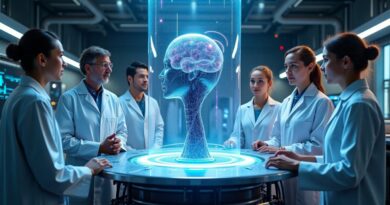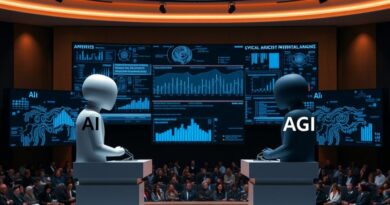How AI is Transforming App Development for Everyone
From Silicon Valley boardrooms to neighbourhood cafés, a quiet revolution is reshaping the very foundations of technology creation
The dream has always been tantalizingly simple: What if anyone, regardless of their technical background, could transform their brilliant idea into a functioning mobile application? For decades, this remained the exclusive domain of skilled programmers and well-funded development teams. Today, thanks to artificial intelligence, that dream is rapidly becoming reality.
A Vision Decades in the Making
Steve Wozniak, the legendary Apple co-founder and tech visionary, is set to discuss the future of AI at Creatio’s No-Code Days Florida 2025, where he’ll explore how artificial intelligence is fundamentally changing our relationship with technology creation. His upcoming keynote underscores a remarkable shift that’s been gaining momentum: the democratisation of app development through AI-powered tools.
This transformation represents more than just technological progress—it’s a paradigm shift that echoes the early days of personal computing, when Wozniak himself helped bring powerful technology into the hands of everyday users. Just as the Apple II made computing accessible to non-engineers, today’s AI-powered development platforms are dismantling the traditional barriers between ideas and implementation.
The Revolution Unfolds
No-code AI has transformed the way businesses leverage artificial intelligence, allowing average business users to deploy AI models without a background in development, data science, or technology. The statistics are staggering: what once required months of development time and substantial financial investment can now be accomplished in minutes, often at a fraction of the traditional cost.
The technology operates through two primary mechanisms: intuitive drag-and-drop interfaces that allow users to visually construct applications, and intelligent wizards that generate fully functional apps based on simple question-and-answer sessions. Platforms like BuildFire AI can create mobile applications by simply asking users questions about their business, automatically generating content, suggesting features, and building app structures based on specified goals.
Consider the remarkable efficiency gains: BuildFire AI can help create content, suggest features, and build a basic app structure by asking about your business goals, even pulling design elements from your website to ensure brand consistency. This level of automation would have seemed like science fiction just a few years ago.
Beyond Simple Apps: The Scope of Possibility
The applications extend far beyond basic mobile apps. Modern AI app builders allow users to create sophisticated applications just by providing a few prompts, enabling the development of:
Business Intelligence Platforms: Tools that transform raw data into actionable insights without requiring data science expertise. Companies are using AI-powered platforms to predict customer behaviour, optimise supply chains, and identify market opportunities with unprecedented accuracy.
Customer Service Solutions: Intelligent chatbots and support systems that can handle complex queries, learn from interactions, and provide personalised responses—all created without writing a single line of code. Tools like Webflow’s no-code solutions enable the creation of sophisticated customer interaction platforms.
Healthcare Applications: Diagnostic tools, patient management systems, and health monitoring applications that can be developed by medical professionals who understand patient needs but lack programming knowledge.
Educational Platforms: Interactive learning environments, assessment tools, and student management systems created by educators who intimately understand their students’ requirements.
The Technical Magic Behind the Curtain
The no-code AI landscape of 2025 promises groundbreaking shifts with AI-powered development platforms integrating advanced machine learning capabilities, enabling real-time code suggestions and automated testing. These platforms employ sophisticated natural language processing to interpret user requirements and translate them into functional code. GitHub Copilot, Zapier’s automation tools, and other AI-powered coding assistants are revolutionising how applications are built.
The underlying technology represents a convergence of several AI breakthroughs: machine learning models trained on millions of code repositories, natural language understanding systems that can interpret human intentions, and automated testing frameworks that ensure reliability. Popular platforms like Bubble, Glide, Thunkable, and Google AppSheet are leveraging these technologies to create increasingly sophisticated development environments.
Visual development has evolved to include advanced features such as database integration, API connectivity, user authentication, and payment processing—all accessible through intuitive interfaces that require no technical knowledge. According to Gartner research, over 70 percent of enterprise apps will be built using low-code/no-code technologies by 2025.
Transforming Industries, One App at a Time
The impact extends across virtually every sector. In healthcare, doctors are creating patient monitoring apps tailored to specific conditions. Restaurant owners are building custom ordering systems that integrate seamlessly with their existing operations. Non-profit organisations are developing donor management platforms that perfectly match their unique workflows.
The three main benefits—accessibility, speed, and cost—hold true regardless of specific use cases, giving businesses access to cutting-edge technology that enables users to produce more results than ever before. Small businesses that previously couldn’t afford custom software development are now competing with enterprise-level functionality.
The Democratisation Effect
This technological shift is creating what economists call “democratising effects”—removing traditional gatekeepers and empowering individuals to participate in markets previously closed to them. The implications are profound:
Economic Empowerment: Entrepreneurs in developing economies can now create sophisticated applications without the infrastructure costs traditionally associated with software development.
Innovation Acceleration: Domain experts—whether they’re teachers, doctors, farmers, or artists—can now directly translate their insights into technological solutions without relying on technical intermediaries.
Rapid Prototyping: Business ideas can be tested and refined through functional prototypes created in hours rather than months, dramatically reducing the risk and cost of innovation.
Challenges and Considerations
This democratisation isn’t without challenges. Quality control becomes crucial when development barriers are lowered. Security considerations must be addressed when non-technical users create applications handling sensitive data. Scalability concerns arise when applications built on simplified platforms need to handle enterprise-level demands.
However, leading platforms are addressing these concerns through automated security scanning, built-in compliance frameworks, and scalable cloud infrastructure that grows with application demands. Modern no-code development platforms are increasingly incorporating enterprise-grade security features and governance tools.
Looking Towards Tomorrow
Industry leaders gathering at events like No-Code Days Florida 2025 will explore insights on the latest in AI, new era CRM, and no-code technology, suggesting that we’re still in the early stages of this transformation. The trajectory points towards even more sophisticated capabilities: AI assistants that can understand complex business requirements and automatically generate enterprise-grade applications, intelligent systems that can optimise and refactor applications for peak performance, and collaborative platforms where human creativity and artificial intelligence combine to solve previously intractable problems.
The convergence of artificial intelligence and no-code development represents more than a technological trend—it’s a fundamental shift in how we approach problem-solving and innovation. As these tools become more sophisticated and accessible, we’re witnessing the emergence of a new class of creators: individuals who combine domain expertise with AI-powered development capabilities to build solutions that were previously impossible.
The New Renaissance
We stand at the threshold of a new renaissance in technological creation. Just as the printing press democratised knowledge distribution and the internet democratised information access, AI-powered development tools are democratising the ability to create sophisticated technology solutions.
This transformation promises to unleash a wave of innovation from unexpected sources: the small business owner who creates the perfect customer management system, the teacher who develops an educational tool that transforms learning, the healthcare worker who builds an application that saves lives. The future belongs not just to traditional programmers, but to anyone with imagination, determination, and access to these remarkable AI-powered creation tools.
The question is no longer whether you can build your dream application—it’s whether you’re ready to begin.
We’d love your questions or comments on today’s topic!
For more articles like this one, click here.
Thought for the day:
“Hypocrisy is the ultimate power move. It is a way of demonstrating that one plays by a different set of rules from the ones adhered to by common people.” Michael Shellenberger



